A five-year study of the incidence of disease among residents of radiation-contaminated buildings was recently completed, showing that the possibility of chromosome aberration -- damage to DNA -- was proportional to long-term exposure to low-dose radiation.
From November 1995 to June 2000, a research team at National Yang Ming University (陽明大學) kept track of more than 4,100 sample people who once lived in buildings that had been constructed in Taipei City between 1982 and 1983 using radioactive steel reinforcing bars.
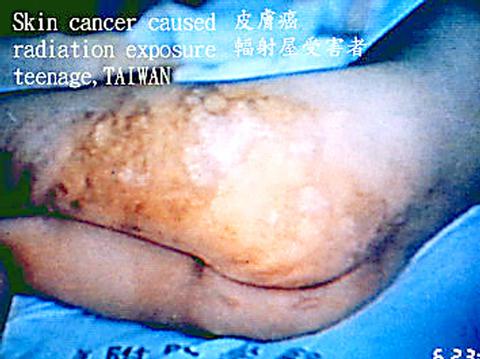
FILE PHOTO: RADIATION SAFETY AND PROTECTION ASSOCIATION TAIWAN
A high incidence of diverse cancers was discovered among samples taken from the group.
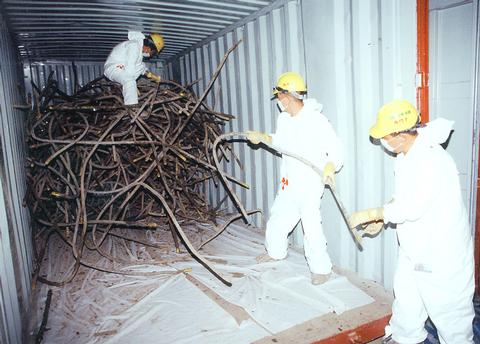
PHOTO: LIN WEN-HUANG, TAIPEI TIMES
The researchers said that cancer could be induced by various factors, including personal lifestyle and environmental and occupational conditions. Exposure to radiation exceeding safety limits is also a factor that deserves close attention, they said.
"We found that DNA damage and chromosome aberration was closely related to samples' long-term exposure to low-dose radiation," Chang Wu-shou (
The 4,100 sample patients, who have been receiving treatment at Taipei Municipal Jen-ai Hospital, are among some 7,800 residents recorded by the Taipei City Government as victims of radiation contamination.
Eighty-nine of the 4,100 samples were diagnosed with cancer, including cervical cancer, breast cancer, liver cancer, leukemia and thyroid cancer. Researchers said that high incidence of the disease might be attributed to chronic low-dose radiation exposure.
Over the course of the research period, 39 of the 89 cancer sufferers died.
Researchers said that the situation did not mean that the mortality from cancer in the group was higher than that in other population groups because there was no direct link between cancer and the patients' exposure to low-dose radiation.
Researchers, however, concluded that excessive radiation did have a negative impact on humans.
"For example, we discovered that the height of children who had been exposed to radiation [exceeding the safety limits] was generally below average," said Chang, an environmental health sciences professor. He also said that the incidence of cataracts (白內障) among children who lived in radiation-contaminated buildings was higher than the national level.
"We also concluded that radiation causes damage to white blood cells, weakening people's immune systems," Chang said.
Unpleasant reminder
Chang's study, supported by the National Health Research Institute (
Officials from the council contacted Chang several times, asserting that his research on low-level radiation would not result in any new scientific discoveries. They told him that a low dose of radiation has been demonstrated to be beneficial to humans.
Chang, however, said the council should be ashamed of itself for discouraging him from conducting his research because Taiwan was the only country which could provide such samples for medical research.
"Contaminated buildings in other countries would be dismantled immediately after radiation pollution was confirmed," Chang told the Taipei Times.
In the early 1980s, rebar contaminated with Colbalt-60 was used in the construction of more than 100 buildings in several counties in Taiwan. The situation was not publicly known until a 1992. One day that summer a Taiwan Power Company (Taipower,
High amounts of radiation had actually been detected years earlier. In 1985 a dentist had an x-ray machine set up in his apartment in Minsheng Villas (民生別墅) in Taipei and dangerous amounts of radiation had been detected. The dentist was banned from operating the machine. However, AEC officials did not mention to residents that high levels of radioactivity came from the walls of the building rather than the x-ray machine.
The truth was exposed later. Because of a dispute over promotions at the council, high-ranking officials revealed in 1992 that AEC officials had been involved in a cover-up of the radiation-contaminated buildings.
After a reporter from the Liberty Times discovered that radiation levels at the villa exceeded safety limits by hundreds of times, a comprehensive check was carried out on thousands of buildings constructed between 1982 and 1984 in Taipei City. More than 100 buildings, including office buildings, schools and kindergartens in the city were confirmed to be contaminated by radiation.
At the time, thousands of residents, young and old, were identified as having been exposed to more than 1 milli-Sievert per year (mSv/y), a safety limit set by the International Radiation Protection Association (IRPA), for up to 12 years. Following the investigation in Taipei, buildings with radioactive reinforced steel bars were discovered elsewhere in the country, including Taipei, Changhua, and Taoyuan counties and also Keelung City.
Hsu Ssu-ming (許思明), secretary-general of the Radiation Safety and Protection Association Taiwan (RSPAT), told the Taipei Times that the radiation-contaminated reinforced steel bars discovered to date only account for a small portion of the radioactive bars.
Hsu said that an ironworks produced 20,000 tonnes of contaminated rebar but so far the government has discovered only 7,000 tonnes of the product.
The 7,000 tonnes of contaminated rebar was used in more than 2,000 homes and 30 schools, affecting more than 10,000 residents.
Hsu said that potential dangers from undiscovered radiation contamination continue to threaten the public because the ironworks lost all records of the steel bars.
"Where are undiscovered radiation-contaminated buildings? They could be all over the island," Hsu said.
Health check
"We strongly encourage victims to have free medical examinations to take care of their health," Hsu said.
He pointed out that many victims relocated from the radiation-contaminated buildings ignore the potential threats to their health after they have moved away.
A teenage boy, who relocated to Kaohsiung County after going to a primary school contaminated by radiation in Taipei for two years, ignored the notification from the Taipei City Government and missed chances to receive treatment. He later discovered he had leukemia. By the time the Tzu Chi Foundation (
The boy, however, was not one of the subjects in Chang's research.
"The government has lost contact with too many victims and are therefore no longer getting any help," Hsu told the Taipei Times.
A group of residents led by Minsheng Villas residents established the Radiation Victims' Association Taiwan to fight for compensation from the government and to raise public awareness that being exposed to radiation was dangerous.
Many of the victims had spent their life savings on the apartments they saw as their dream homes, but which later became the source of their nightmares.
In 1993, three officials were censured for neglect of duty after having learned in 1985 that Minsheng Villas was seriously contaminated by radiation. In 1994, the Taipei District Court accepted lawsuits for state compensation from 65 residents of Minsheng Villas.
But it was not until 1997 that the court made a judgment in favor of 57 of the residents and told the government to compensate them for physical, property, and psychological losses resulting from the intentional negligence of government officials who had concealed information.
That was the only successful case for victims who asked for state compensation.
The AEC's role
Fewer than 20 of the almost 200 buildings discovered to be contaminated by radiation were properly dealt with. Some residents continued to live in the radiation-contaminated buildings because the selling price offered by the AEC was far less than what the homeowners had originally paid.
The AEC also carries out studies relating to radiation-contaminated buildings. Researchers from the medical school of National Taiwan University confirmed only that the rate of death of thyroid-related diseases among the victims was higher than that of other population groups.
Another research paper by the AEC published in the British medical journal the Lancet in February last year shows that the incidence of chromosomes being affected in people who lived in radiation-contaminated buildings was substantially higher than that of control groups.
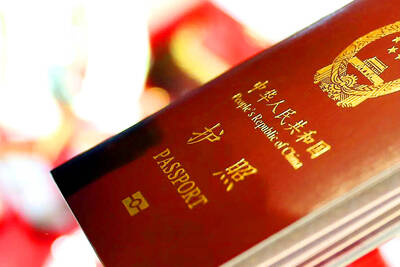
The Ministry of the Interior (MOI) is to tighten rules for candidates running for public office, requiring them to declare that they do not hold a Chinese household registration or passport, and that they possess no other foreign citizenship. The requirement was set out in a draft amendment to the Enforcement Rules of the Public Officials Election and Recall Act (公職人員選舉罷免法 ) released by the ministry on Thursday. Under the proposal, candidates would need to make the declaration when submitting their registration forms, which would be published in the official election bulletin. The move follows the removal of several elected officials who were
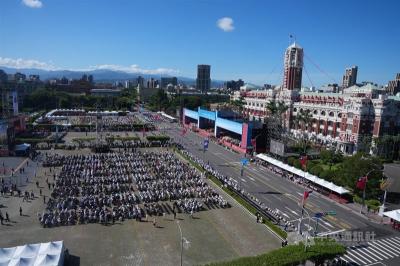
The Republic of China (ROC) is celebrating its 114th Double Ten National Day today, featuring military parades and a variety of performances and speeches in front of the Presidential Office in Taipei. The Taiwan Taiko Association opened the celebrations with a 100-drummer performance, including young percussionists. As per tradition, an air force Mirage 2000 fighter jet flew over the Presidential Office as a part of the performance. The Honor Guards of the ROC and its marching band also heralded in a military parade. Students from Taichung's Shin Min High School then followed with a colorful performance using floral imagery to represent Taiwan's alternate name
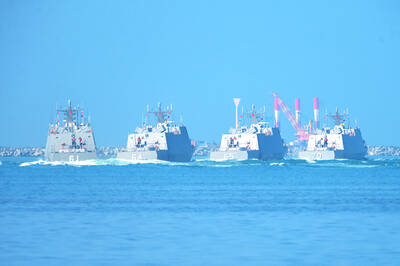
FOUR DESIGNATED AREAS: Notices were issued for live-fire exercises in waters south and northwest of Penghu, northeast of Keelung and west of Kaohsiung, they said The military is planning three major annual exercises across the army, navy and air force this month, with the navy’s “Hai Chiang” (海強, “Sea Strong”) drills running from today through Thursday, the Ministry of National Defense said yesterday. The Hai Chiang exercise, which is to take place in waters surrounding Taiwan, would feature P-3C Orion maritime patrol aircraft and S-70C anti-submarine helicopters, the ministry said, adding that the drills aim to bolster the nation’s offshore defensive capabilities. China has intensified military and psychological pressure against Taiwan, repeatedly sending warplanes and vessels into areas near the nation’s air defense identification zone and across

A Chinese takeover of Taiwan would severely threaten the national security of the US, Japan, the Philippines and other nations, while global economic losses could reach US$10 trillion, National Security Council Deputy Secretary-General Lin Fei-fan (林飛帆) wrote in an article published yesterday in Foreign Affairs. “The future of Taiwan is not merely a regional concern; it is a test of whether the international order can withstand the pressure of authoritarian expansionism,” Lin wrote in the article titled “Taiwan’s Plan for Peace Through Strength — How Investments in Resilience Can Deter Beijing.” Chinese President Xi Jinping’s (習近平) intent to take Taiwan by force